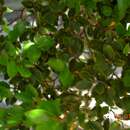en
names in breadcrumbs


Nothofagus betuloides, Magellan's beech[1] or guindo, is a tree native to southern Patagonia.
In 1769, Sir Joseph Banks collected a specimen of the tree in Tierra del Fuego during Captain Cook's first voyage.[3]
Its occurrence on Hornos Island earns it the distinction of being the southernmost tree on Earth.[4]
Nothofagus betuloides grows from southern Chile and southern Argentina (40°S) to Tierra del Fuego (56°S). It is found from sea level to 500 m (1,600 ft) above mean sea level. One specimen growing near the southeastern corner of Hornos Island (Cape Horn) was identified in 2019 as the southernmost tree in the world.[4]
It is an evergreen tree up to 25 m (82 ft) tall, with a columnar appearance. In its natural environment, it tolerates cold winters and absence of heat in summer. Specimens from the southern forests resist temperatures down to −20 °C (−4 °F).
It succeeds in Scotland. Trees planted in the Faroe Islands, which were imported directly from its southernmost distribution in Tierra del Fuego, have turned out to be very hardy.[5]
The wood has beautiful marks, and is pinkish, hard, and semiheavy; it is used in furniture and construction.
Fagus betuloides in Joseph Dalton Hooker's Flora Antarctica 1844–1846, from the Ross expedition of 1839–1843
Nothofagus betuloides, Magellan's beech or guindo, is a tree native to southern Patagonia.
In 1769, Sir Joseph Banks collected a specimen of the tree in Tierra del Fuego during Captain Cook's first voyage.
Its occurrence on Hornos Island earns it the distinction of being the southernmost tree on Earth.